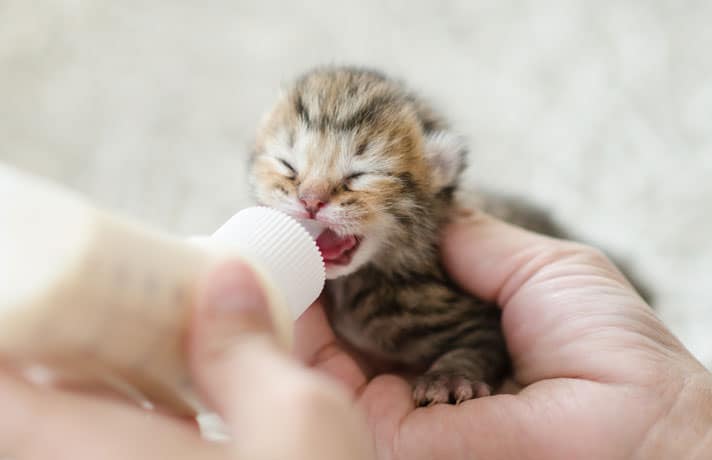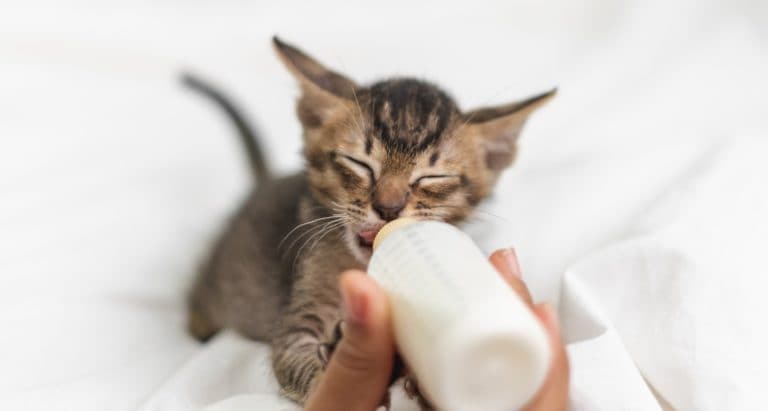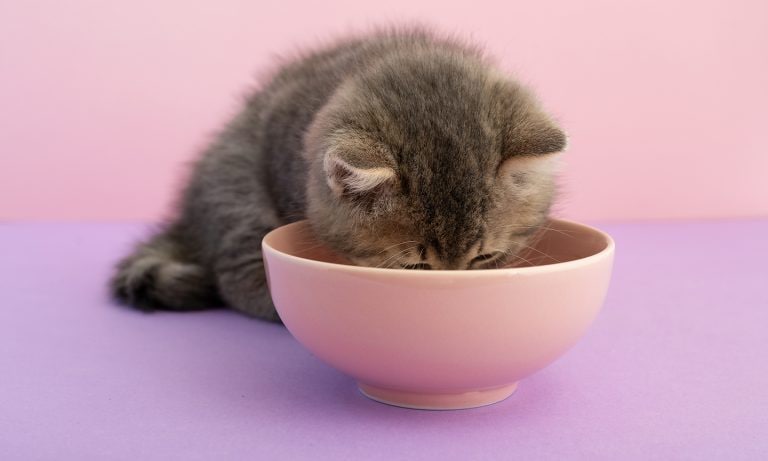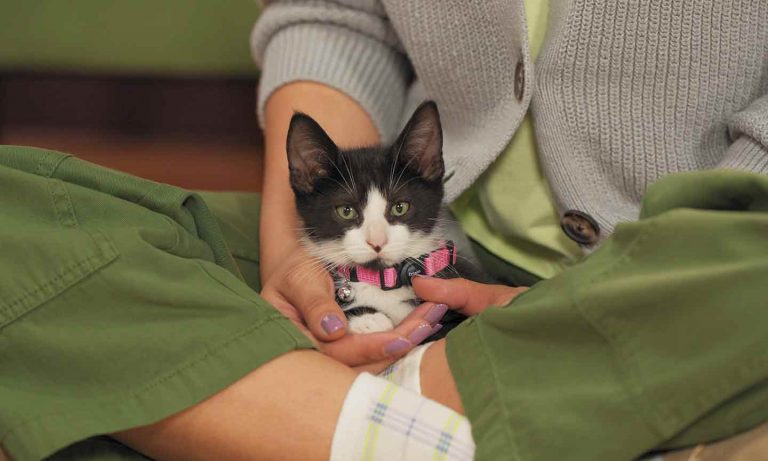A kitten may need to be bottle-fed if she is orphaned or separated from her mother or if the mother is unable to nurse the kitten. When committing to bottle-feeding and raising kittens, care must be taken to provide premium nutrition, good nursery conditions and healthy emotional development.
The kitten is considered a neonate up to 4 weeks of age. This means that special nutritional and environmental conditions are required. The condition and age of a kitten prior to acquisition can influence the survival of the orphan. Hypothermia, dehydration, disease and birth defects are common causes of death in kittens. With a kitten of any age, I recommend getting a veterinary exam to identify and treat, if possible, any defects or illness. Starting with a healthy kitten helps to increase the chance of successful bottle-feeding.
Newborn kittens within the first week of life may have to be fed via a stomach tube due to underdeveloped swallowing reflexes. Tube feeding should only be done after detailed instruction provided by a veterinarian to prevent death due to aspiration or trauma.
Food To Use When Bottle-Feeding A Kitten
A quality kitten milk replacement formula should be used for bottle-feeding. Feline milk replacer is composed of water, proteins, carbohydrates, fats, minerals and vitamins and is similar to a mother’s milk. Cow’s milk should NOT be used, as it is not a nutritionally adequate substitute for kitten milk replacer.
Bottle kits designed for feeding kittens, as well as milk replacement formulas, are readily available and can be found at most pet supply stores. Instructions on preparing the nipples and milk replacer are provided on the packaging. I do not believe that syringes and eyedroppers are an acceptable means of administering milk, as it is very difficult to deliver adequate amounts safely and efficiently.
Milk replacement formulas are usually available in either powder or ready-to-use liquid. If using powder, mix only enough to supply 48 hours worth of feeding. This helps reduce bacteria and formation of rancid milk, which can lead to gastrointestinal upset and even death. Extra ready-made liquid formula can be frozen in small portions and thawed for later use.
Replacement milk should be warmed to 100 degrees Fahrenheit before feeding. Use a meat or baking thermometer to determine the temperature of the replacement milk. Do not guess. If you warm in the microwave, be sure to stir well before checking the temperature. Try not to overheat, because too much heat can break down and destroy proteins, reduce the water content and thicken the formula. For the same reason, it’s not recommended to reheat and reuse any unused portion from a previous feeding.
The bottle and nipples must be clean for each use. In addition to a thorough daily soap and water cleaning of bottles and nipples, wash them with diluted white vinegar at least three times a week to further remove oils, odors and bacteria from them. Some people prefer to do the vinegar wash daily.
Kitten Bottle-Feeding Schedule
Kittens begin nursing within hours after birth and continue on and off throughout the day and night. In a natural setting, kittens would stay on mother’s milk and then start experimenting with solid foods around 4 to 5 weeks of age. This means that the caretaker of an orphaned kitten must provide bottle-feeding until the kitten is at least 3 to 4 weeks old. Newborn kittens should be fed six to eight times a day with a gradual reduction in frequency to about three to four times daily by the time they are 2 to 3 weeks of age. They will let you know when they are hungry. Healthy kittens less than 4 weeks old will likely wake up in the middle of the night and very early morning crying for cat food and must be fed. This could happen even after 4 weeks of age, but by that time they may go about four to five hours before waking. Kittens that are less than a week old or in ill health must be fed every three hours regardless of the time of day.
Kittens Need Help To Eliminate And Burp
During the bottle-feeding stage of life, physical stimulation of the anal and genital areas must be performed after each feeding to induce bowel and urine production. This simulates the mother cat’s natural behavior of licking each kitten for this purpose. Use a very soft cloth or cotton pad to gently rub the anus and genitalia. During feeding, position the kittens as naturally as possible to resemble nursing off the mother. Online video and photo resources can help demonstrate this. The same consideration should be used when stimulating urine and feces production. Proper positioning helps the kitten relax for better nursing and elimination.
Kittens who do not nurse well or cry constantly are indicating that something is wrong. Rapid, labored breathing or unpleasant odor can all indicate a disease process and require immediate medical attention.
With bottle-feeding, swallowing air can result, so the kittens ideally should be burped after each meal to reduce bloating and discomfort. Burp a kitten by loosely wrapping her in a small towel or blanket while holding her close to your body and gently patting her back.
Weaning A Kitten
After 4 weeks, the weaning process can begin with the introduction of soft solid foods. Weaning should ideally start at 4 to 5 weeks of age. Bottle-feeding is still required, but quality, canned kitten food or commercial kitten weaning formula should be introduced. Bottle-feeding combined with canned foods or weaning formulas provide high water content. Separate water sources do not generally need to be introduced until the kitten is fully weaned. Around the time of weaning, kittens will start to have bowel movements and urinate on their own.
Normal (And Abnormal) Kitten Growth
Average newborn kittens typically weigh around 100 grams +/- 10 grams and should gain about 10 to 15 grams per day. By the age of 6 weeks, kittens should weigh about 500 grams, or just over one pound.
It is common for bottle-fed kittens to develop diarrhea or constipation. If this occurs, a veterinarian should be consulted immediately. Overfeeding, milk quality and lack of proper genital stimulation can all potentially lead to gastrointestinal issues.
Normal neonatal feces are pasty yellowish tan in color. Green, yellow or white watery stools are not normal and should be brought to the attention of a veterinarian. Stools should be formed and darkening in color by the time kittens are weaning at about 4 to 5 weeks of age.
The Kitten Nursery
The nursery for kittens can be in the form of a cat carrier or other suitable washable container with passive ventilation. The size of container somewhat depends on how many kittens are being cared for. It should allow some space for crawling around but be secure such that the kittens cannot climb over sides or become entangled in material. As kittens age, they will begin to explore more, and their enclosure will have to be modified. Because kittens must be bottle-fed so frequently, many caretakers use an easily portable carrier for most of the day.
The bedding should be soft and without dangers of snagging nails or getting trapped in pockets. Even with stimulation to encourage urination and defecation immediately after feeding, many times bedding becomes soiled with urine and feces. It is vital that bedding be changed frequently so that it is kept clean and dry. Small, soft blankets can be used directly in contact with the kittens with a layer of absorbent towel underneath to wick away urine and moisture.
Thermoregulation is important for the neonate kitten. The nursery box should be kept at close to 85 to 90 degrees Fahrenheit for the first week of life. By the kittens’ second week of life, ambient temperatures can be reduced to 80 degrees. By weaning at 5 weeks, the kittens can better regulate their own body temperatures and an ambient temperature of 70 degrees is acceptable. Extreme caution must be taken when providing any heating source, such as heating pads or lamps. Kittens should have access to a temperature gradient, which means that they can move away from or to the heat source as desired.
When more than one kitten is housed together, genital damage can occur in males due to siblings attempting to nurse on the exposed prepuce. If not caught early, the preputial tissue can become significantly swollen and infected. This is a challenging problem to avoid, and sometimes separation of male kittens is the only solution. To reduce the chances of this happening, make sure kittens are fed on a regular schedule that meets their hunger needs. Too much time between feedings may result in hungry kittens waking up and suckling on a male sibling’s body.
Kitten Emotional Health
Kittens who do not have access to a mother or surrogate cat require special emotional support to reduce stress and improve their chance of thriving. When a mother cat nurses and cleans her kittens, there are calming, happy hormones released in both the mother and the kittens. Caretakers should not only try and mimic these behaviors but to also spend some time gently interacting with the kittens, not just feeding them. In general, eyelids begin to open around 10 to 14 days of life and vision is poor the first three weeks after that. Kittens are therefore very sensitive to touch and smell during this time.
Newborns need lots of sleep in between meals, but as they mature they become more interactive and begin exploring their surroundings. Quietly talking to and handling the kittens for short periods of time after feeding helps bond them to their human caretakers and stimulate brain development. This kind of care can help form the personality of a secure individual, which can make a good pet later.
Care must be taken to NOT get kittens in the habit of biting hands and fingers during play, as it can turn into a nasty behavior that is difficult to break as they get older.
Kittens raised by themselves with no siblings can respond well to a same-sized stuffed animal that can be used as a “sparring buddy” to satisfy the natural behavior of wrestling with siblings. Proper play and socialization during the window of 2 to 8 weeks of age is critical to reduce undesirable behaviors of aggression or rough play later on.
The Beginning Of A Happy Life
Bottle-feeding and raising orphaned kittens to an adoptable age can be difficult but very rewarding work. Ensuring that all of the physical and emotional needs of an orphaned kitten are met can influence the kitten’s entire life. Happy, healthy individuals have a better chance at a future becoming someone’s loving pet.
By: Dr. Heidi Pavia-Watkins
Share:









